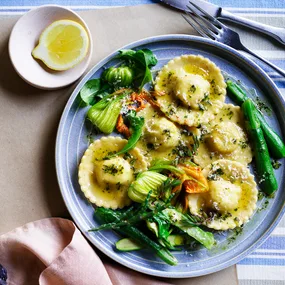Spaghetti, eggs, cheese and guanciale – this is the base of a traditional carbonara recipe. For a true Italian experience, it’s important to serve this pasta dish as soon as you toss the eggs through – leave it any longer, and they’ll keep cooking with the heat of the spaghetti and become scrambled.
In fact, you should probably eat this carbonara straight from the pan.
Ingredients
Method
Cook pasta in a large saucepan of boiling salted water until al dente (8-10 minutes).
Meanwhile, heat oil in a frying pan over medium-high heat, add guanciale and sauté until starting to crisp (2-4 minutes). Set aside and keep warm.
Drain pasta, reserving 2 tbsp cooking water. Add to guanciale with eggs, pecorino, reserved cooking water and freshly ground black pepper to taste. Toss until pasta is coated and sauce begins to thicken (20-30 seconds), then serve immediately, scattered with parsley and extra pecorino to the side.
Guanciale is cured meat from the side of the pig’s face and coppa is cured pork shoulder or neck; both are available from select delicatessens and Italian butchers.
Notes
What is carbonara sauce made of?
In a traditional carbonara recipe like this one, the creamy sauce is made from the eggs, pecorino, reserved pasta water (which helps thicken it). It’s also flavoured and enhanced by the olive oil, rendered fat from the guanciale. But the key is in tossing it and allowing it to thicken naturally.
Can you use cream in carbonara?
While cream is included in some carbonara recipes, it’s not a traditional ingredient. Some chefs and foodies would go as far as saying cream should never be used in carbonara. This is because the creaminess in authentic spaghetti alla cabonara comes from how all the ingredients are added and cooked together. So adding cream will change the taste and texture of the sauce.
But there are plenty of other creamy pasta recipes that you can try with cream (as well as some others without it).
What goes with spaghetti carbonara?
Spaghetti with carbonara is a meal on its own. But if you want a few courses for dinner, garlic bread, an antipasti platter or salad or a light fennel salad work well.
If you’re pairing carbonara with wine, choose one that’s full-bodied and has good acidity. For example, an oaked chardonnay, viogner or even a young merlot can complement the richness of the carbonara.










